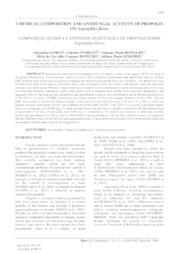Chemical composition and antifungal activity of propolis on Aspergillus flavus.
Chemical composition and antifungal activity of propolis on Aspergillus flavus.
Author(s): LORINI, A.; WOBETO, C.; BONALDO, S. M.; BOTELHO, S. de C. C.; SINHORIN, A. P.
Summary: Research has indicated the antifungal activity of ethanol extracts from propolis (EEP) on fungi of the genera Phakopsora, Colletotrichum, and Cercospora. Here, chemical compositions and antioxidant activity of three EEP (propolis from Scaptotrigona polysticta stingless bee and two types produced by Apis mellifera - red and brown) were evaluated and their action against Aspergillus flavus was investigated. Ash, dry extract, total phenolic and total flavonoid contents were determined. Phenolic composition was evaluated by high performance liquid chromatography, with using the following reference substances: gallic acid, caffeic acid, ρ-coumaric acid, ferulic acid, quercetin, kaempferol, and apigenin. Tests on mycelial growth, sporulation, and germination of spores were performed to assess the biological activity of the EEP on A. flavus. All EEP showed low dry extract content (<11%) with adequate amounts of ash (<5%). The red EEP (Apis mellifera) showed the highest contents of total phenolic and total flavonoid (5.38 and 2.77 g 100 g-1), while the highest recorded antioxidant activity was exhibited by brown EEP (92.9%). The EEP of S. polysticta presented higher levels of ρ-coumaric acid (10.99 mg g-1), while red and brown extracts from A. mellifera stood out with the highest levels of quercetin (27.26 mg g-1) and gallic acid (5.88 mg g-1), respectively. No extract was effective in inhibiting mycelial growth and sporulation of A. flavus, but red EEP inhibited spore germination. On the basis of these results, it is suggested that the inhibitory effect of red EEP on spore germination may be associated with increased levels of flavonoids found in it as compared with the other extracts investigated here.
Publication year: 2018
Types of publication: Journal article
Observation
Some of Embrapa's publications are published as ePub files. To read them, use or download one of the following free software options to your computer or mobile device. Android: Google Play Books; IOS: iBooks; Windows and Linux: Calibre.
Access other publications
Access the Agricultural Research Database (BDPA) to consult Embrapa's full library collection and records.
Visit Embrapa Bookstore to purchase books and other publications sold by Embrapa.

